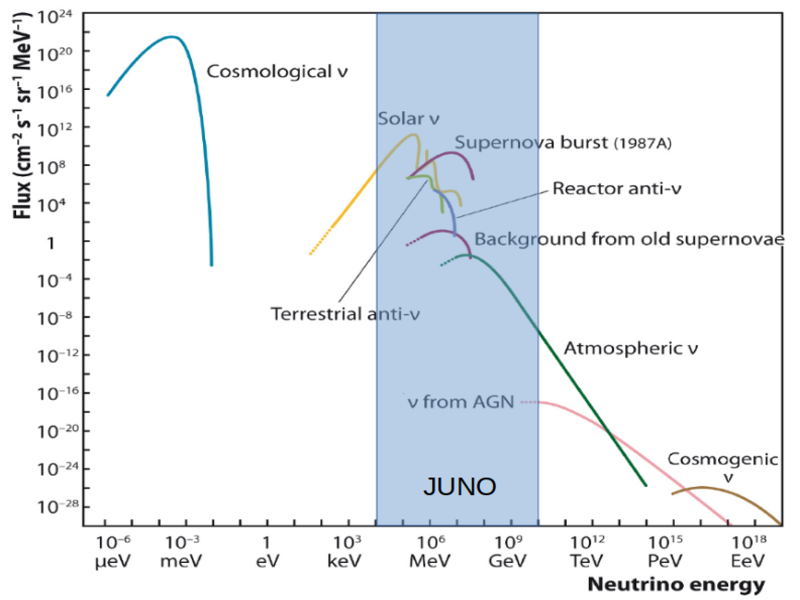Neutrino physics and the JUNO experiment
Neutrino physics today is one of the key challenges of our understanding of Nature. During the last decades the new phenomenon of neutrino oscillation was observed (2015 Nobel Prize of physics to T. Kajita and A. McDonald for this discovery). Neutrino physics today is a very active research area, a key result being the high precision measurement of the parameter sin22θ13 by the Daya Bay experiment, and subsequent results from RENO, Double Chooz and T2K. The relatively large value measured for θ13 opens up in particular possibilities for searching for CP violation effects in neutrino oscillation experiments, and for determining the structure of the neutrino mass spectrum. The most pressing questions about neutrinos are: Is the normal hierarchy (NH) or inverted hierarchy (IH) realized in nature? Is the CP-symmetry violated in neutrino oscillations? What is the absolute mass of the neutrinos? Are neutrinos Majorana or Dirac particles? Besides these fundamental questions, the clarification of the neutrino mass hierarchy is crucial for the interpretation of results of CP-violation experiments in neutrino oscillations and of neutrino-less double-beta experiments searching for Majorana neutrinos.
The JUNO detector
The detector will be located at 700 m underground and consists of 20 ktons of liquid scintillator contained in a 35 m diameter acrylic sphere, instrumented by more than 17000 20-inch photomultiplier tubes (PMT). Two vetoes are foreseen to reduce the different backgrounds. A 20 ktons ultrapure water Cerenkov pool around the central detector instrumented by 2000 20-inch PMTs will tag events coming from outside the neutrino target. It will also act as a passive shielding for neutrons and gammas. In addition, a muon tracker will be installed on top of the detector (top muon veto) in order to tag cosmic muons and validate the muon track reconstruction. The top muon veto will use the OPERA experiment target tracker, in which ULB and FNRS have been contributors.

The international JUNO collaboration was established in 2014, the civil construction started in 2015 and the production has started in 2019 and 2020 for the main components (as for example the PMTs). The start of the data taking is expected in 2023.
The JUNO electronics readout system
The JUNO electronics system will have to cope with signals from 18000 large (20-inch) PMTs and 25600 small (3-inch) PMTs of the central detector as well as 2400 PMTs installed in the surrounding water pool. One of the innovative aspects of JUNO is its electronics and readout concept. With JUNO, a flexible approach is chosen: every 3 PMTs will have their own “intelligence” as self-monitoring (currents, voltages, temperatures) and will have the possibility to implement various data processing algorithms (for example trigger request generation and data compression). The JUNO electronics system can be separated into mainly two parts: (i) the front-end electronics system performing analog signal processing (the underwater electronics) and after about 100 m cables, (ii) the back-end electronics system, sitting outside water, consisting of the data acquisition (DAQ) and the trigger. The main challenge of the whole electronics system is the very strict criteria on reliability: a maximum of 0.5% failure over 6 years for the PMT full readout chain, as well as the large data transfer of 1.25 Gb/s that needs to be delivered over 2 times 100 m Ethernet cables.
For the front-end electronics, the global control unit (GCU) will digitize the incoming analog signals with custom designed high speed ADU (analog to digital converter unit). The GCU will store the signals in a large local memory under the control of the FPGA (Field-Programmable Gate Array) waiting for trigger decision and send out possible event data as well as trigger requests to the outside-water system. A back-end card will be used as a concentrator and the incoming trigger request signals will pass an equalizer for compensating the attenuation due to the long cables. An FPGA mezzanine card (called TTIM, for trigger timing interface mezzanine) will collect all differential trigger request signals, align them to a certain trigger count, make a sum, and send the result to the next stage (RMU, for Reorganize & Multiplex Unit) and finally to the center trigger unit over an optical fibers.
The group activities : physics analyses
The group is involved in the physics analysis in view of preparing for the start of data taking. Two general topics are of interest to the group:
- Multi-messenger neutrino astronomy, involving core-collapse supernova neutrinos at O(10 MeV) energies as well as neutrinos from astrophysical sources (GRBs, compact binary mergers, etc) in sub-GeV energy scale. For the second energy range, the study of atmospheric neutrino as the main background source is relevant. In fact, core-collapse supernova are one of the most interesting multi-messenger sources, and JUNO will be a next-generation detector sensitivite to all of the supernova neutrino flavors, contributing to the physics breakthroghts expected from the next Galactic explosion. In particular, the group is taking the lead in time-dependent studies of the supernova neutrino lightcurve, as well as contributing to the efforts in the SNEWS2.0 network.
- Neutrino oscillation physics. JUNO will be able to measure the neutrino oscillation parameters as well as the neutrino mass ordering via two different neutrino sources: reactor anti-electron neutrinos and all-flavor atmospheric neutrinos. The group is contributing to the atmospheric neutrino working group analysis, with two different goals: the measurement of the atmospheric neutrino spectrum at low energies, and the determination of the neutrino mass ordering combining the atmospheric neutrino and reactor neutrino data, which in particular will also allow to further constrain the CP violation phase.
Moreover, the group is involved in the study of a level-1 trigger based on neural networks for the JUNO experiment, allowing to assess the low-energy regime (below 0.2 MeV) using less hardware ressources than the current design.

The group activities : BEC design, test and production
The group contribution:publishs and talks
People Involved
Staff : Barbara Clerbaux (physicist), Yifan Yang (Dr. Ing.), Benoît Debègre (electronician)
PostDoc : Marta Colomer (since 10/2020)
PostDoc : Feng Gao (since 9/2022)
PostDoc : Amina Khatun (since 4/2024)
PhD student : Pierre-Alexandre Petitjean (assistant, since 10/2018)
PhD student : Hui Wang (CCNU, since 02/2024)
Alumni
Peng Wang (NUAA, postdoc CSC scholarship from 01/2020 to 01/2021)
Shuang Hang (NUAA, CIRD visitor PhD from 07/2019 to 12/2019)
Jinlin Song (NUAA visiting Master student from 01/2020 to 03/2020)
Jianmeng Dong (IHEP visiting PhD CSC scholarship from 07/2016 to 07/2018)
